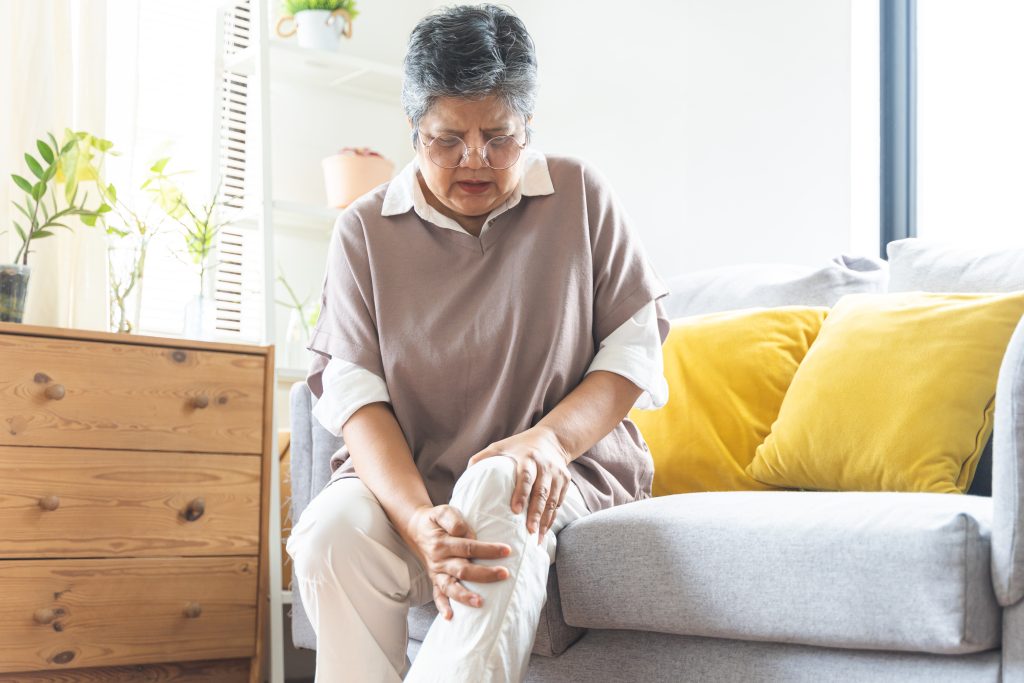While sitting, your knees are at rest – they’re getting a break from distributing your body weight to your feet and enabling you to run and walk around. But sitting for a long time every day, whether while working at a desk or binge-watching TV without flexing the joints that you depend on, can cause tendons and muscles to get stiff and painful when you stand up again.
Some amount of stiffness and discomfort can be normal, but if it’s been weeks of feeling substantial pain every time you stand up, you deserve to find answers and treatment. We’ll start by brainstorming potential reasons for knee pain when standing up after a long time as well as giving you options for how to take care of it.
Knee conditions that can be made worse by sitting
Although sitting isn’t always directly responsible for knee pain, it can worsen existing issues like the following.
Postural problems
Not all of us live up to the goal of having perfect posture, especially if we’re sitting at a desk for several hours straight every day. Without knowing it, we may cross our legs or place uncomfortable pressure on our knees that affects our overall posture, if not specifically the pain we might be feeling in the knees.
Arthritis
Arthritis in the knees, particularly osteoarthritis, can be aggravated when the joints are held or rested in a fixed position for long periods. The lack of lubrication caused by inactivity may make the knee joints feel stiff, leading to stiffness or what some describe as a “rusty” sensation when they finally stand up.
Patellofemoral pain syndrome (runner’s knee)
Despite its association with athletes, patellofemoral pain syndrome can also affect people who spend long hours sitting. This condition occurs when the cartilage under the kneecap (patella) wears down or is strained, often due to prolonged pressure when seated.
If you already experience one of these conditions, the discomfort you feel after sitting is likely caused at least in part by the underlying condition. For the best treatment options for your diagnosis, see a physical therapist.
Treating knee pain while sitting
Just because you’re experiencing knee pain with or without a previously diagnosed condition doesn’t mean your only option is knee replacement surgery. There are several things to try that are more conservative, holistic, and affordable than surgical solutions to knee pain.
At-home treatments for knee pain after sitting
Small changes to your daily routine can make a noticeable difference when it comes to knee pain:
- Change your sitting position: Avoid crossing your legs or slumping in your chair. Instead, sit with your feet flat on the ground and your knees at a 90-degree angle. This can take time to feel comfortable but can, with sustained effort, become your “new normal.”
- Take regular breaks: Try to stand up and move around every 30 to 60 minutes. Even a quick walk around the room or some light stretches at your desk can activate your muscles and relieve stiffness.
- Stretch daily: Stretch your legs and knees every day to maintain flexibility. Simple stretches like hamstring and quad stretches or knee extensions can help.
- Strengthen supporting muscles: Building strength in your quadriceps, hamstrings, and calf muscles can reduce pressure on your knees and support better leg alignment.
- Use heat or ice: For occasional discomfort, use a heating pad to loosen stiff muscles or apply an ice pack to reduce swelling.
Personalized guidance from a physical therapist
If at-home remedies don’t seem to alleviate your discomfort, it may be time to consult a physical therapist. A professional can help identify specific issues and offer personalized solutions to relieve your symptoms and prevent further complications.
Although every person and treatment plan is unique, here’s what you can generally expect from a physical therapist when addressing knee pain:
- Comprehensive evaluation: Your therapist will assess your knee mobility, posture, and daily habits to determine the root cause of your pain.
- Tailored exercise plans: Expect a personalized program of stretches and strength-building exercises specifically designed to improve your knee health.
- Posture correction: If desired, you can gain practical tips for better ergonomics and/or working biomechanics to prevent future pain.
- Supportive therapies: Depending on your needs, your therapist might use manual therapy techniques, kinesiology tape, or recommend supportive devices to alleviate strain.
Discover the knee pain treatment that’s right for your lifestyle
Something as simple and difficult to avoid as knee pain after sitting shouldn’t be a normal part of your everyday life. With a combination of better daily habits and, when needed, professional support, you can keep your knees feeling flexible and strong with less pain.
Our physical therapists are eager to show you how you can heal and protect your knees no matter what your lifestyle goals are. Start a conversation with our team by calling a clinic near you or by requesting an appointment online today.
